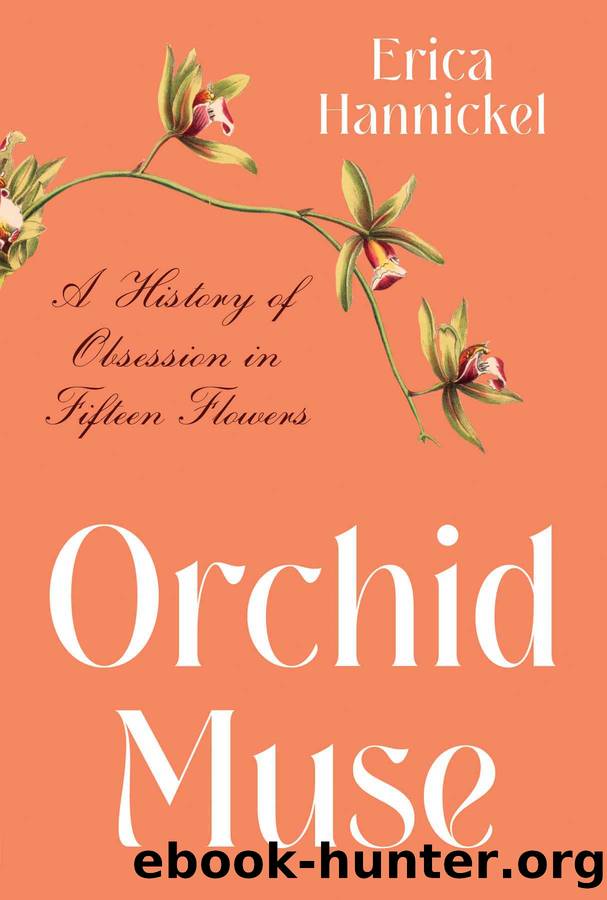Orchid Muse by Erica Hannickel

Author:Erica Hannickel
Language: eng
Format: epub
Publisher: W. W. Norton & Company
Published: 2022-11-03T00:00:00+00:00
Paphiopedilum Niobe, a primary hybrid of P. fairrieanum and P. spicerianum, was registered by British orchid breeders Veitch & Sons in 1889. Roebling soon used the cross to make other paphiopedilum hybrids. Warner, Williams, and Moore, Orchid Album (1893).
Roeblingâs hybridizing program for his favorite orchid genera, cattleyas and paphiopedilums (called cypripediums in his day) required the same sort of long-term planning, development, and adaptation to adverse conditions that his bridges did. Paphiopedilums are perhaps both the most anthropomorphized and oddest orchids for their often hairy and alluring petals and pouches. In addition, paphiopedilums seem as though their heads (the flowers) are suspended in air, too heavy for their necks (thin stems) to support. Much like engineering a suspension bridgeâs perfectly balanced âcatenary curve,â engineering attractive curves and proportions in orchidsâalong with a strength to withstand inhospitable environmentsâmarks successful orchid hybrids. And in the long term, it is not just the creation and naming of a new orchid that matters in the wider world of horticulture; it is whether the hybrid has enough positive traits to be of use in future orchid breeding. By this measure, Charles Roebling was successful in revolutionizing steel wire construction and in adding to the growing diversity of beautiful, collectible orchids.
Roebling was not a saint, of course. People remarked about his gruff personality, forged while breaking regular strikes at his factories and rebuilding after dozens of devastating fires, which occurred by accident and by arson (disgruntled employees and anarchists were regularly accused of destruction of property). His factories spilled wastes into the rivers they were built on, and tons of slag exited their furnaces. And although close with his immediate family, including his brother Washington Roebling, wife, daughters, and a single sonâof at least three bornâwho lived beyond early childhood, once the Roeblingâs Sons Company was incorporated, the brothers often went six months without speaking to one another.
Download
This site does not store any files on its server. We only index and link to content provided by other sites. Please contact the content providers to delete copyright contents if any and email us, we'll remove relevant links or contents immediately.
How to Be a Bawse: A Guide to Conquering Life by Lilly Singh(7394)
Spare by Prince Harry The Duke of Sussex(5078)
Millionaire: The Philanderer, Gambler, and Duelist Who Invented Modern Finance by Janet Gleeson(4386)
Machine Learning at Scale with H2O by Gregory Keys | David Whiting(4199)
Never by Ken Follett(3800)
Harry Potter 02 & The Chamber Of Secrets (Illustrated) by J.K. Rowling(3627)
The Heroin Diaries by Nikki Sixx(3497)
Urban Outlaw by Magnus Walker(3342)
Harry Potter and the Prisoner of Azkaban (Book 3) by J. K. Rowling(3304)
Fairy Tale by Stephen King(3226)
Japanese Design by Patricia J. Graham(3112)
The Man Who Died Twice by Richard Osman(2998)
The Club by A.L. Brooks(2863)
Stacked Decks by The Rotenberg Collection(2812)
Will by Will Smith(2795)
Harry Potter and the Deathly Hallows (7) by J.K. Rowling(2648)
Churchill by Paul Johnson(2510)
The Chimp Paradox by Peters Dr Steve(2303)
Borders by unknow(2232)
